The best ways to hide speaker wires can be challenging after wiring your home audio system.
Long speaker wires can tangle and make your setup untidy. If speaker wires are exposed, they can also cause potential accidents like tripping, which are avoidable with proper hiding.
Fortunately, there are speaker wire hiding tricks that will make your home neat and eliminate wire dangers. This article will help you learn the best ways to hide speaker wires.
Table of Contents
- Solution 1: Carpet
- Solution 2: Baseboards
- Solution 3: Camouflage with paint
- Solution 4: Hardwood floors
- Solution 5: Nail-in fastener cable clips
- Solution 6: Cover with adhesive vinyl roll
- Solution 7: Use a ghost wire
- Solution 8: Use cable organizers
- Solution 9: Hide alongside your light strips
- Solution 10: Drywall
- Solution 11: Crown molding
- Solution 12: Chair rail molding
- Solution 13: Snake through walls and ceiling
- Solution 14: Connect Wirelessly
- Conclusion
Solution 1: Carpet
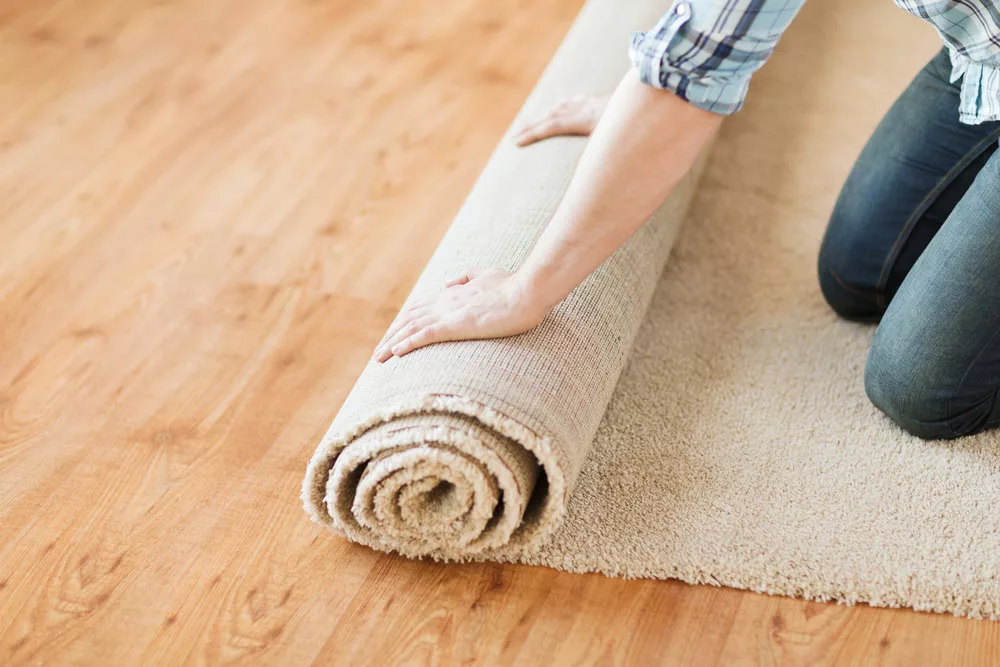
Man unrolling a carpet.
If you have messy speaker wires in a carpeted room, tucking them under the rug is the easiest way to tidy your speaker setup. Also, you won’t need to use any tools since you only require a little time and your hands.
Solution 2: Baseboards
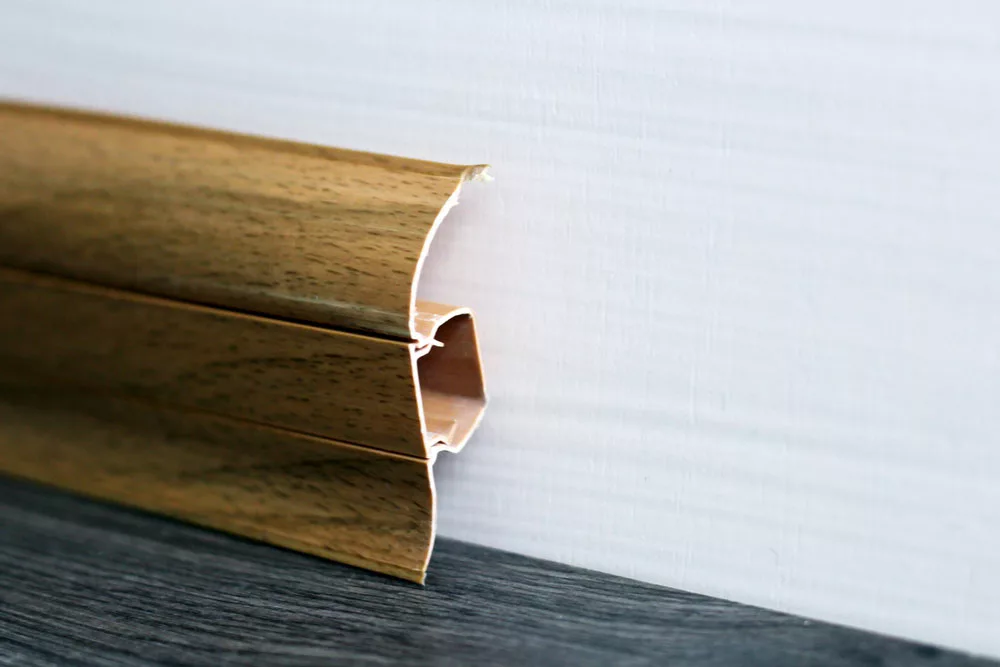
Molding to install wires along the baseboard
The best way to hide speaker wires under baseboards may require some labor and some tools. Most importantly, a utility knife.
First, break the top seal paint to access the baseboard. Using a utility knife or a razor, run along the seal to detach it between the wall and the baseboard.
Once you break the seal, remove the base moldings to determine where you plan to run the speaker wires.
Begin with the first stud while carefully handling the moldings as you avoid cracking them.
Keep removing the moldings until you reach the last stud.
Place the baseboards aside and label them in the correct order you removed them.
You can use sticky notes to attach their numbers.
At this stage, you will work with two choices.
One is putting the wires in the space between the baseboard and the hardwood flooring.
The second option is customizing a channel between the moldings and the wall where you will place the wires.
Or acquire moldings that have channels through them.
Tuck the wires in the moldings without any obstacles obscuring their passway.
Reinstall the moldings while following the sequence you removed so that they can fit perfectly.
Solution 3: Camouflage with paint
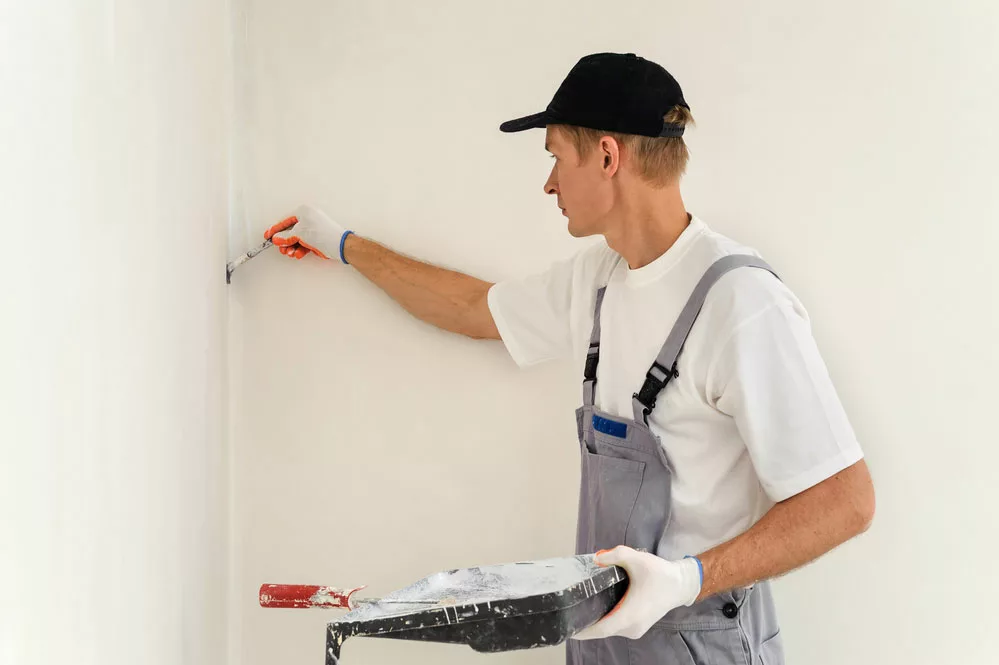
Man painting walls.
Painting is a budget-friendly way to hide exposed audio wires.
You require some paint that matches the room color, a paintbrush, and some of your time.
If the speakers are wall-mounted, paint the speaker wires with the color of the wall.
Start by arranging and organizing the speaker wires using cable or zip ties according to their route.
Use hooks and screws to attach the wires to the wall.
Then, find a paint sample that matches the walls and camouflage the cables using a paintbrush over the wires.
If you change the room colors, hiding the cables is also possible by painting them with the new color.
Solution 4: Hardwood floors

Set of working tools on a hardwood floor
You will use tools like raceways and runners to hide wires under hardwood floors.
You can also use ghost wires to run speaker wires on the floor.
Raceways and runners are tracks or channels that hide cables and can be plastic or metal.
They are available in a variety of colors. Therefore, you can find patterns that match your wood floor.
Installing them is also easy, as you do not need extra modifications of the channels.
Arrange the raceways in the path the audio cables will pass on the floor. Insert the cables and cover them with a carpet.
If you are installing in the floors, you can hide the wires like the process in the baseboards above.
Solution 5: Nail-in fastener cable clips
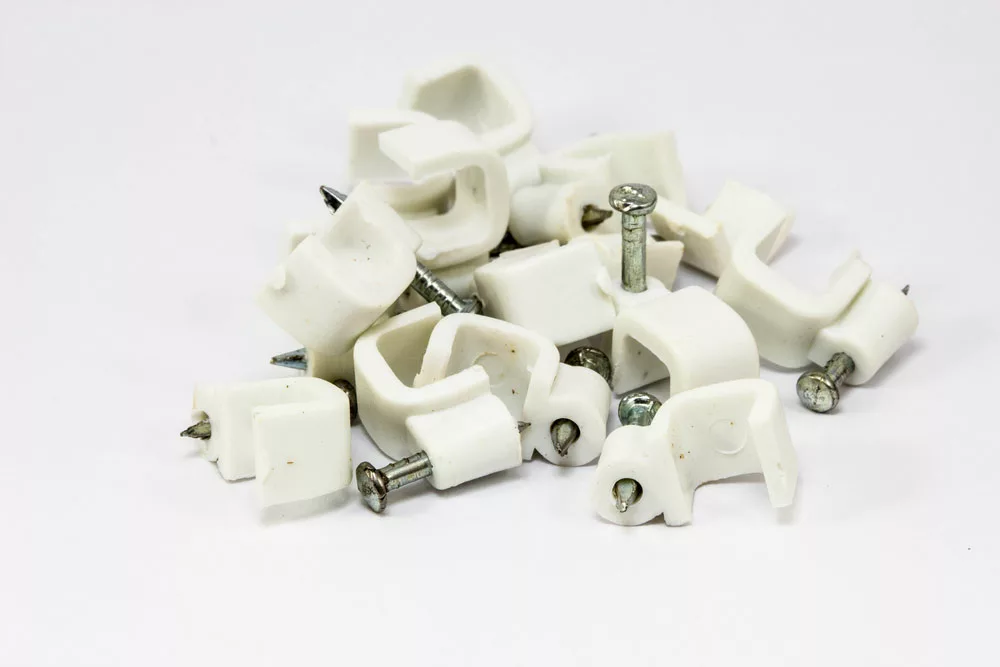
A pile of white cable clips
Nail-in fastener cable clips are handy when hiding speaker wires under baseboards or camouflaging them with paint.
These are nail clips that are C-shaped and have a nail that drives into walls to hold the wires in place.
They are cost-friendly and come in packs of 100 or more; therefore, you only need to spend a little money to hide your speaker wires.
When using cable clips, determine where to start running the speaker wires and where they need to end. Measure that distance and ensure the wire is long enough.
Ensure that you place them evenly and they are at a uniform height.
Thread the wire through the cable clips. Start at one end while threading the wire through each of them while following your determined route.
Ensure that each wire is taught and straight as you go.
Once you put the cable clips in place, you may paint them to match the wall or use a wire cover to hide the wires.
Solution 6: Cover with adhesive vinyl roll
An adhesive vinyl roll is a thin, flexible, and self-adhesive material that is versatile and suitable for hiding audio cables.
Start by measuring the speaker wire length you want to cover and add a few extra inches to ensure you have enough vinyl to work with.
Cut the adhesive vinyl roll while ensuring it is wide enough to cover the wire completely.
Peel the back of the vinyl roll to expose the adhesive side.
Starting at one end, place the sticky side of the vinyl roll around the audio cable and wrap it against the wall.
Smooth out any air bubbles or wrinkles using a squeegee or credit card while wrapping around the wire.
Continue wrapping the vinyl roll around the wire while slightly overlapping each wrap.
Upon reaching the wire’s end, use scissors or a utility knife to trim the vinyl to the desired length.
If necessary, use a heat gun or hair drier to make it conform to the wire more tightly.
Your wires should completely disappear.
You may paint over the vinyl roll to hide it completely.
Solution 7: Use a ghost wire
Ghost wires are adhesive speaker wires that can stick on flat surfaces.
It resembles a wide thin piece of tape that sticks on walls and features a peelable conductive side.
The Ghost Wire 2.0 is the best adhesive speaker wire on the market.
It comes in white; therefore, you can paint it to disappear completely. You can hide it on the wall or floor at home due to its thin characteristics.
To install the ghost wires, you need a pair of scissors, a utility knife, and a screwdriver to fasten the connectors.
The following are the steps you should follow.
Begin by measuring the distance from your speakers to the audio receiver to determine the length of the ghost you need.
Cut the ghost wire to the desired length using scissors or a utility knife.
Strip off the protective covering on both ends of the ghost wire to expose the conductive side.
Run the ghost wire along the wall, baseboards, or other surfaces while pressing the adhesive tape to secure it in place.
Connect the ends of the wire using the appropriate connectors.
Solution 8: Use cable organizers
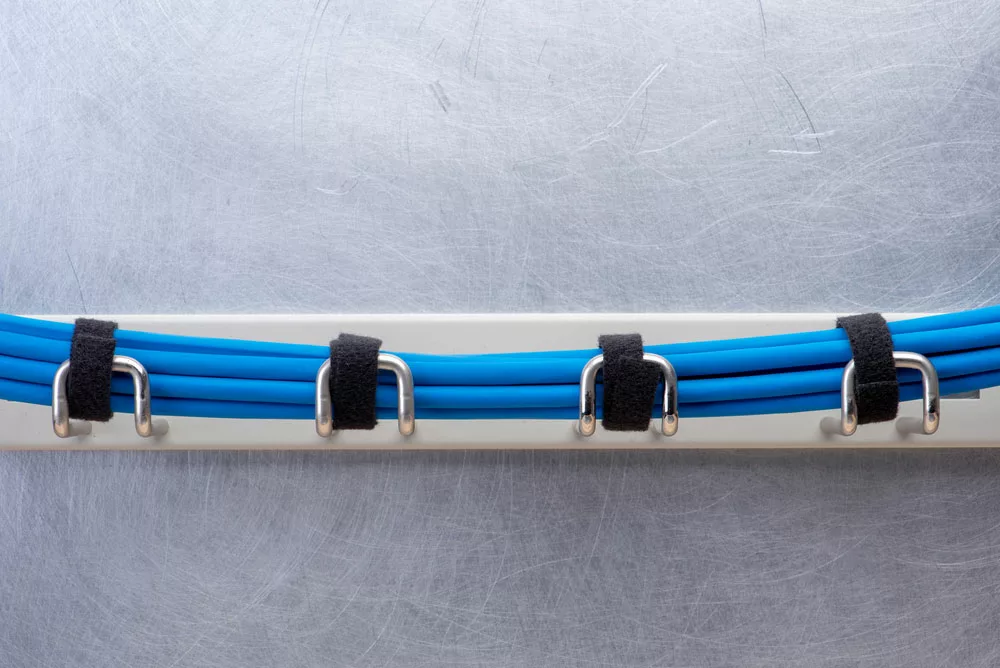
Running wires on cable ties along a wall
One of the advantages of using cable organizers is their ease of installation, and you can remove and reposition them as you need.
Cable organizers are also a great way to reduce clutter and organize your space.
Here is the best way to hide speaker wires when using cable organizers.
Like most speaker hiding techniques, first, determine what path you want your speaker wires to take from your audio receiver.
Choose the cable organizers you want, such as raceways, cord covers, and cable ties.
Attach the cable organizers to the wall while spacing them to ensure they are level.
Route the speaker wires through the cable organizers, ensuring no twisting or kinking.
Use zip and cable ties to secure speaker wires to the cable organizers while ensuring the wires are tight but not too tight to damage them.
Trim excess zip ties using cable cutters or scissors. Enjoy a neat setup.
Solution 9: Hide alongside your light strips
If you have LED light strips, they can help you hide speaker wires alongside them. The light strips differ in length. Therefore, you can use long ones for long cables to your advantage.
You can fix the light strips on the wall using adhesive tape or other mounting accessories such as wire hooks or clips.
Hang the wires behind the LED strips while fastening them using the hooks.
Solution 10: Drywall
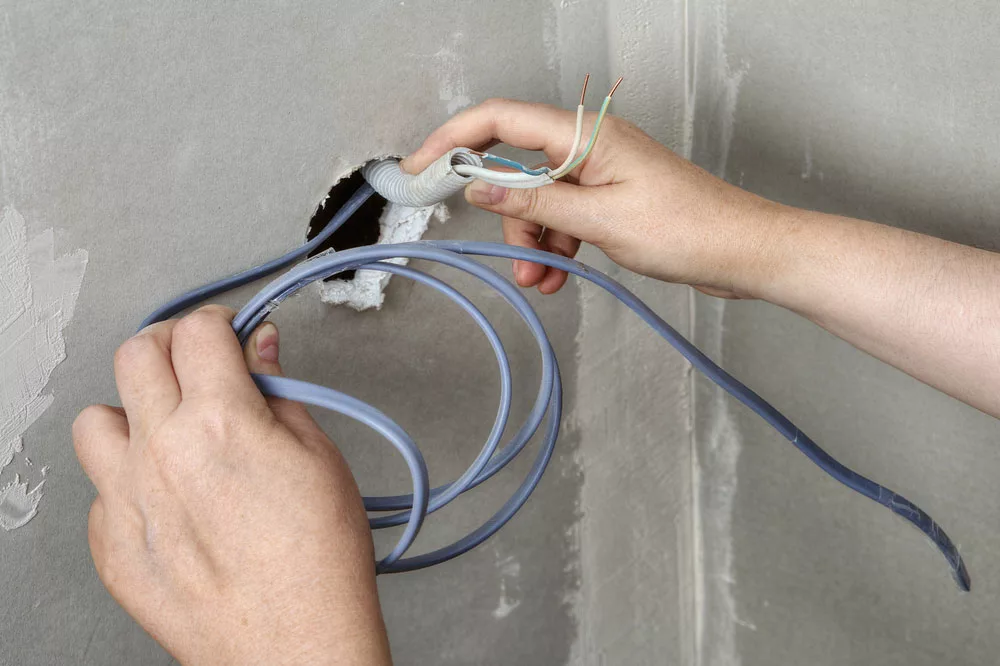
Pulling wires through a hole in a drywall
When installing speaker wires in drywall, choose what route the wire will take from the speaker to the receiver.
Make sure there is space inside the walls to accommodate the audio cables.
Use a stud finder to locate any studs, pipes, or electric wires in the drywall.
Make necessary adjustments to your path to avoid obstacles. Learn how to locate electrical wires here.
Cut a hole in the drywall where you will place the speakers. Use a drywall saw to make the holes.
Fish the wire through the hole you have created, using a fish tape or wire snake to guide it through the drywall.
Pull the wire through the other side of the wall and run it inside the space.
When you reach the receiver’s location, cut another hole in the drywall and fish the wire through the other side.
Finally, connect the wires to the speakers and audio receivers with the appropriate connectors.
Solution 11: Crown molding
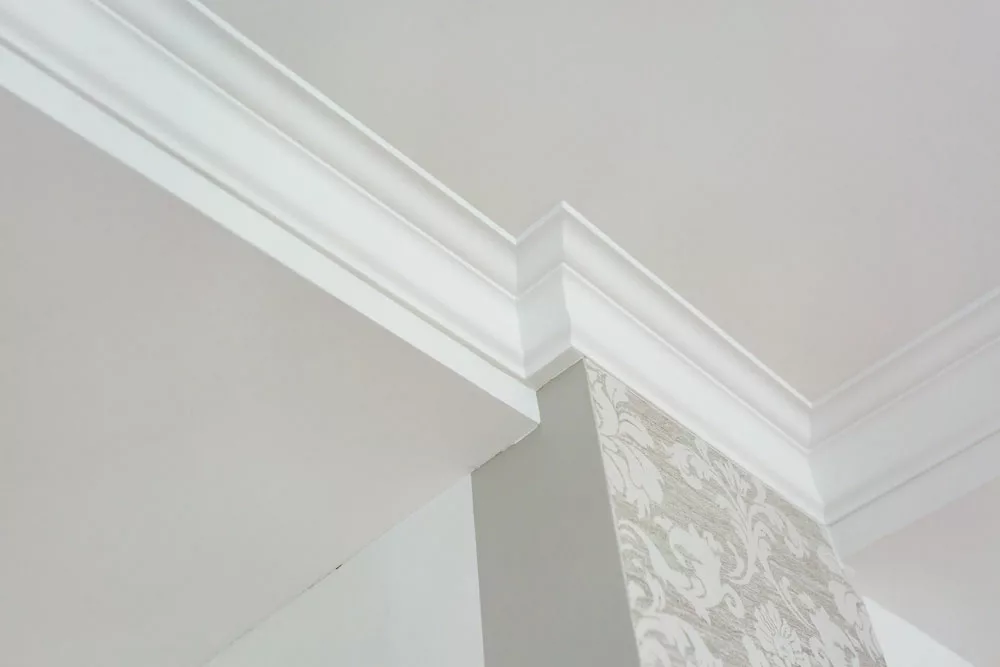
Crown molding on the ceiling of a house
Many home interiors today have crown moldings in their construction. Crown moldings run from the base, where the floor starts to the top of the wall, where the ceiling begins. Hiding the audio cables under the crown molding is a good idea.
Peel off the moldings using a knife and carve a way inside the wall to let the wire pass through.
Place the wires in the curved passway. After the cables completely hide, attach the molding back.
Sometimes, you may find hollow moldings that make placing wires in the open space easy.
Solution 12: Chair rail molding
While crown molding runs from the floor to the ceiling, chair rail moldings run anywhere between the wall.
Besides their aesthetic role, you can run cables through chair rail moldings.
First, peel them from the wall and curve inside the moldings to create a space where the cables will run.
Reinstall the rail chair moldings after the wires disappear entirely from the wall.
Solution 13: Snake through walls and ceiling
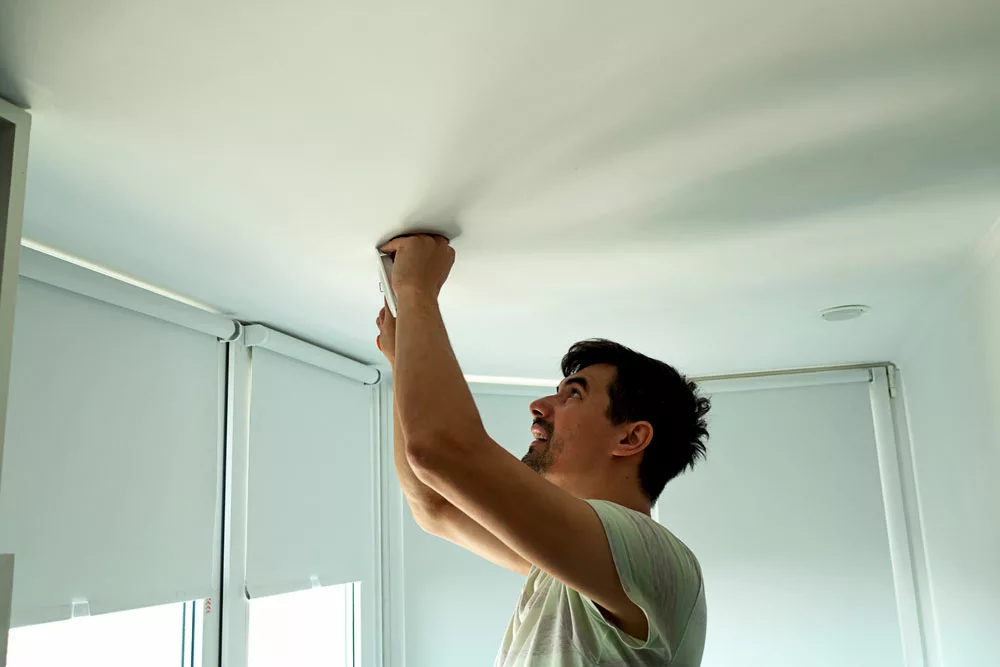
Professional pulling wires through a ceiling
Hiding your speaker wires by snaking them into walls and ceilings requires effort and a few hand tools.
They include drills, stud finders, and fish tapes.
Before beginning the task, determine if your home is compatible with in-wall or in-ceiling speaker wiring.
In this stage, you need to hire an expert in speaker wiring since they have the skills to handle such speaker setups.
However, if you are good at DIY speaker wiring, you are good to go.
Begin by drilling small holes in the wall or ceiling where the wires will pass.
Use the fish tape to pass the wires through the holes while routing them to the speakers and the audio receivers.
Attach speaker wall plates which are ports that can power several speakers using different ports or HDMI ports.
Solution 14: Connect Wirelessly
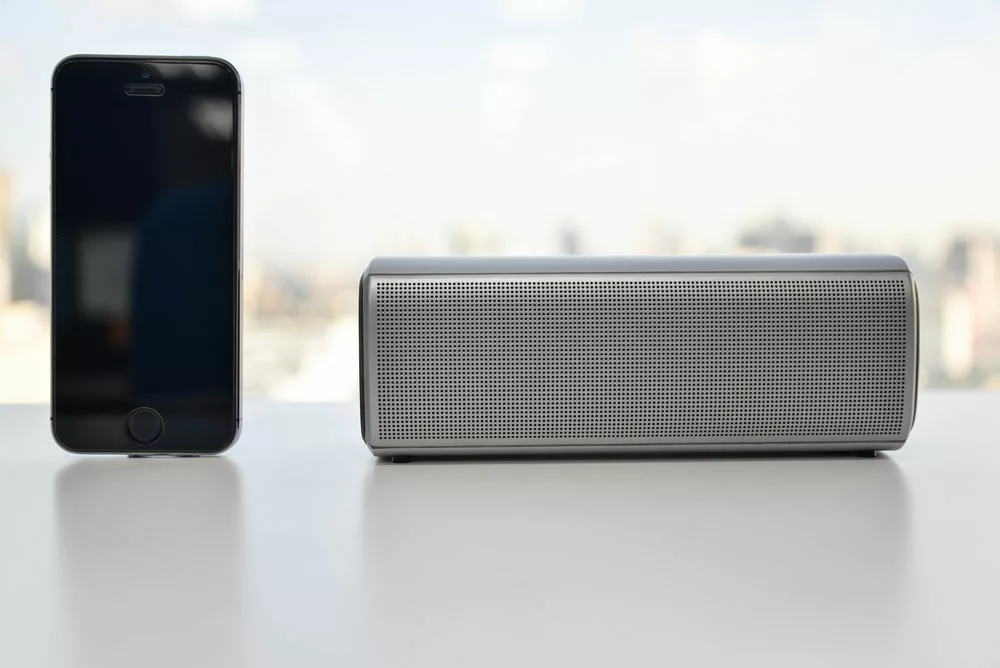
Portable speaker and a mobile phone on a white background
Among the best ways to avoid speaker wires is using wireless speakers.
The market has several options if you are in the market for wireless speakers.
They require Bluetooth connection and charging after some time.
The wireless speakers also have portability advantages as you can carry them anywhere.
Conclusion
This article discusses the best ways to hide speaker wires.
With multiple choices, from hiding under rugs and using ghost wires to going wireless, any option is valid.
The hiding technique you choose should eliminate untidiness and wire-tripping hazards at home.
